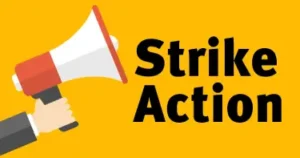
Description:
Explore how Australians can use a payment strike to curb corporate dominance and learn strategies to avoid retaliation.
Introduction:
A radical idea if enough people joined together
In Australia, the influence of large corporations over everyday life has become increasingly pervasive, often at the expense of citizens’ interests. The concentration of economic power among a few key players in industries such as banking, retail, and telecommunications leaves many Australians feeling powerless. However, a payment strike—a coordinated effort to withhold financial support from these corporations—could be an effective way to reclaim control. But how can Australians protect themselves from the potential backlash from these powerful entities?
1. Historical Context and Precedents
1.1. Examples of Successful Economic Strikes in Australia
Australia has a rich history of economic protests, such as the Green Bans of the 1970s, where construction workers, led by unions, refused to work on projects that were considered harmful to the environment or heritage sites. These bans successfully halted developments and protected public interests. Another example is the boycott of Nestlé products in the 1980s, which led to significant changes in the company’s marketing practices about infant formula in developing countries.
1.2. Lessons Learned

These movements highlight the power of collective action in Australia. Key factors for success included strong leadership, widespread public support, and clear communication of the protest’s goals. Applying these lessons to a modern payment strike could galvanize Australians to challenge corporate power effectively.
2. Mechanics of a Payment Strike in Australia
2.1. Definition and Goals
In the Australian context, a payment strike would involve citizens deliberately withholding payments from specific corporations that dominate the economy and act against public interests. The goal is to disrupt these corporations’ cash flow, compelling them to change their practices or policies. This could range from not paying bills to major banks to refusing to shop at certain retail giants.
2.2. Strategic Targets in Australia
Australians could target corporations that have significant control over essential services or that have been involved in unethical practices. Potential targets include:
– Big Four Banks (Commonwealth, ANZ, Westpac, NAB): These institutions have faced criticism for practices like charging fees for no service and manipulating interest rates.
– Supermarkets (Woolworths, Coles):These retailers have been accused of squeezing farmers and small suppliers, leading to unethical supply chain practices.
– Telecommunications (Telstra, Optus): These companies control much of Australia’s communications infrastructure, and their pricing and customer service practices have often been criticized.
2.3. Organizing the Strike in Australia
 Organizing a payment strike in Australia would require using digital platforms and community networks. Steps include:
Organizing a payment strike in Australia would require using digital platforms and community networks. Steps include:
– Mobilizing Support: Engage citizens through social media campaigns, public forums, and community organizations.
– Setting Clear Objectives: Define what the strike aims to achieve, whether it’s forcing policy changes or demanding better practices.
– Using Digital Tools: Platforms like WhatsApp, Telegram, and local forums can help coordinate efforts and share information securely.
3. Potential Impact on Australian Corporations
3.1. Financial Disruption in Key Industries
A payment strike targeting the Big Four banks, for example, could lead to substantial financial losses, affecting their ability to run smoothly. If enough Australians take part, it could force these banks to rethink their fee structures, lending practices, and investment choices.
3.2. Reputation Damage
Australia’s corporate sector is extremely sensitive to public opinion, especially in an era where social media can amplify consumer dissatisfaction. A payment strike that gains traction can severely damage the reputations of targeted corporations, potentially leading to a decline in customer loyalty and shareholder confidence.
3.3. Long-Term Consequences
The long-term effects could include not just financial and reputational damage but also regulatory scrutiny. Australian corporations might face increased pressure from government bodies and consumer advocacy groups to improve their practices, leading to broader changes in corporate governance.
4. Protecting Australian Participants from Corporate Retaliation
4.1. Legal Protections in Australia
Australian law provides certain protections for individuals taking part in economic protests, but the legal landscape can be complex. Corporations might retaliate through legal means, such as reporting missed payments to credit agencies or even taking legal action. Australians should seek advice from legal experts or organizations like the Australian Consumer and Competition Commission (ACCC) to understand their rights.
4.2. Collective Security Measures in Australia
The effectiveness of a payment strike in Australia depends on the strength of the collective. By forming alliances with unions, consumer groups, and other advocacy organizations, participants can create a support network that provides legal aid, financial help, and moral support.
4.3. Digital Privacy and Anonymity
Given the potential for corporate surveillance, Australians taking part in a payment strike should prioritize digital privacy. Using encrypted communication tools, anonymizing payment methods, and educating participants about cybersecurity are crucial steps. Services like Signal for messaging or VPNs for online activities can help protect identities.
5. Overcoming Challenges in the Australian Context
5.1. Addressing Public Reluctance in Australia
Convincing Australians to take part in a payment strike may be challenging due to concerns about financial repercussions and scepticism about the strike’s effectiveness. Clear communication of the strike’s goals and potential impact, as well as providing assurances that participants will not face consequences alone, is essential.
5.2. Countering Corporate Propaganda in Australia
Australian corporations are likely to launch counter-narratives, using media and advertising to discredit the payment strike. Proponents of the strike should be prepared to counter these narratives by engaging independent media, using social media to spread their message, and creating content that highlights the legitimacy and moral standing of the strike.
5.3. Ensuring Sustained Participation in Australia
Maintaining momentum throughout the payment strike is crucial. Regular updates, transparency about progress, and a strong sense of community can help keep participants engaged. Setting clear milestones and celebrating small victories can also boost morale and reinforce the belief that the strike is making a difference.
6. Ethical Considerations in the Australian Context
6.1. Balancing Harm and Good in Australia
While the goal of a payment strike is to challenge corporate power, it’s essential to consider the potential consequences. For instance, a strike against supermarkets could affect suppliers, including farmers, who are already struggling. Strikers should weigh these outcomes carefully and explore alternatives that minimize harm.
6.2. Responsibility to Vulnerable Populations in Australia
A payment strike could disproportionately affect low-income Australians who rely on the services provided by the targeted corporations. To mitigate this, the movement could set up support systems, such as community food programs or financial aid funds, to help those affected by the strike.
7. Case Studies and Hypothetical Scenarios
7.1. Imagining the Impact in Australia
Consider a scenario where Australians collectively refuse to pay their credit card bills to protest exorbitant bank fees. The immediate effect would be financial losses for the banks, leading to increased media coverage and public debate. As the strike gains traction, it could prompt regulatory bodies to investigate banking practices more thoroughly.
7.2. Lessons from Related Movements in Australia
The Australian boycott of certain products during the anti-apartheid movement is a relevant case study. This boycott showed how sustained economic pressure could lead to significant political and social change. Applying similar strategies to a payment strike could amplify its impact.
8. Conclusion
8.1. The Power of Collective Action in Australia
A payment strike offers Australians a powerful tool to challenge corporate dominance. By strategically withholding financial support, citizens can disrupt corporate operations and demand change, leading to a fairer and more just society.
8.2. A Call to Action for Australians
Now is the time for Australians to consider how they can take part in this movement. Whether by joining a payment strike, spreading awareness, or supporting others, every action counts. Together, we can hold corporations accountable and work towards a fairer future.
9. FAQs and Further Resources
9.1. Common Questions for Australians
– What is a payment strike?
A payment strike is a collective refusal to pay for goods, services, or debts to exert pressure on corporations.
– Is a payment strike legal in Australia?
While collective action is protected, participants should be aware of their legal rights and consult legal experts.
9.2. Additional Resources for Australians
Australian Consumer and Competition Commission (ACCC): https://www.accc.gov.au/
Australian Unions Support: https://www.australianunions.org.au/contact-australian-unions/
Digital Privacy Tools for Australians: https://privacyaustralia.net/privacy-tools/
Reader Interaction and Call to Action
Thought-Provoking Question:
Do you think a payment strike could effectively challenge corporate power in Australia? Why or why not?
Call to Action:
Share your thoughts in the comments below and join the conversation. If you found this article insightful, consider subscribing for more content on economic activism.
Social Sharing:
Don’t forget to share this article on social media using the hashtags: #EconomicActivism, #CorporateAccountability, #PaymentStrikeAustralia, #CollectiveAction

I must clarify Denis. Not in favour of withholding payments for services / goods you have actually received. I was mainly agreeing with the concept of not shopping at companies that do not align with your values. For example, if people had a policy of not shopping at a company where the CEO was paid more than ‘x’ (2, 5, 10, 20, 100?) times the wage of the average check-out operator then there would be a very big shift to smaller / independent supermarkets like IGA, Drakes etc. We could also push companies to implement profit-sharing initiatives or we won’t shop with them.
Hi Bruce,
There is probably value in what you say. I am not sure I would agree that IGA is any cheaper than the largers stores. I have noticed that IGA prices have increased considerably in the last year.
I like this idea Denis. The key thing is that it is a voluntary action – no-one forces you to do it, no government makes a law about it, it is just people making a free choice. It is akin to the actions people took to try to help dairy farmers – refusing to buy the cheaper supermarket milk and telling the supermarkets that they were happy to pay more for milk if they could be certain the extra money would actually get to the farmers. When times are tight, it is very difficult to make these kinds of choices but with a lot people doing a little bit, perhaps a lot can be achieved.
Hi Bruce,
I am please you found the post interesting. I think the main issue with the concept of with holding payments is getting enough people together at the same time. As you say, boycots can also be effective.